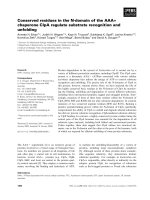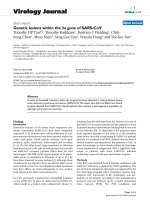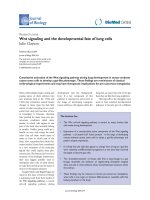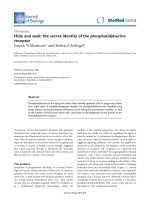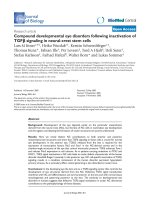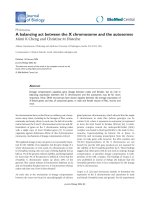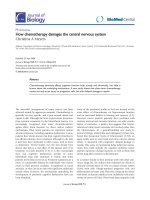Báo cáo sinh học: "Conserved elements within open reading frames of mammalian Hox genes" pps
Bạn đang xem bản rút gọn của tài liệu. Xem và tải ngay bản đầy đủ của tài liệu tại đây (178.29 KB, 4 trang )
Minireview
CCoonnsseerrvveedd eelleemmeennttss wwiitthhiinn ooppeenn rreeaaddiinngg ffrraammeess ooff mmaammmmaalliiaann HHooxx ggeenneess
Joost M Woltering* and Denis Duboule*
†
Addresses: *National Research Centre ‘Frontiers in Genetics’, Department of Zoology and Animal Biology, University of Geneva, Sciences
III, Quai Ernest-Ansermet 30, 1211 Geneva 4, Switzerland.
†
National Research Centre ‘Frontiers in Genetics’, School of Life Sciences, Ecole
Polytechnique Fédérale, 1015 Lausanne, Switzerland.
Correspondence: Denis Duboule. Email:
MMoorree ccoonnsseerrvveedd tthhaann ccoonnsseerrvveedd
Comparisons between vertebrate genomes reveal a range of
highly conserved sequences located within noncoding
regions [1,2]. These conserved elements are typically 50 to
300 nucleotides long and were initially identified by align-
ments of orthologous loci. More recently, whole-genome
sequence comparisons have provided rather exhaustive
accounts of such elements, which were identified using
criteria of various stringencies and (expectedly) are referred
to by different terminologies [1-4]. For example, the best-
conserved class of elements, named ‘ultraconserved elements’,
contains sequences 200 bp long at least and identical
among human, mouse and rat [3]. Another study describes
‘ultraconserved regions’, that is, sequences showing both a
minimum of 95% identity over 50 bp between human and
mouse, and also some homology with their counterparts in
the fish Fugu [4]. As these criteria are somewhat arbitrary, and
because unambiguous functional criteria allowing for a more
relevant classification of these sequences are still lacking, we
shall consider all these sequences as a whole and, for the sake
of simplicity, refer to them as ‘conserved elements’.
Conserved elements are preferentially associated with either
genes encoding transcription factors or genomic loci impor-
tant for development [1]. Ever since they were discovered, it
has been assumed that the function of these elements is,
primarily, to regulate the expression of neighboring gene(s),
as short-range regulators or long-range enhancers, to help
establish the complex and dynamic expression patterns of
these genes [1,5,6]. However, the biological relevance of
these elements is still elusive and several instances in which
conserved elements were removed from the mouse genome
in vivo failed to clearly support this hypothesis (for example
[6]). While conserved elements are mainly present in non-
coding regions, several studies have identified a significant
number overlapping with coding regions (for example [3]).
Interestingly, these latter elements are usually excluded
from global analyses, probably because their identification
AAbbssttrraacctt
A recent study in
BMC Evolutionary Biology
shows that many of the open reading frames in
mammalian Hox genes are more conserved than expected on the basis of their protein
sequence. The presence of highly conserved DNA elements is thus not confined to the
noncoding DNA in neighboring regions but clearly overlaps with coding sequences. These
findings support an emerging view that gene regulatory and coding sequences are likely to be
more intermingled than once believed.
Journal of Biology
2009,
88::
17
Published: 6 February 2009
Journal of Biology
2009,
88::
17 (doi:10.1186/jbiol116)
The electronic version of this article is the complete one and can be
found online at />© 2009 BioMed Central Ltd
and interpretation represent an additional level of com-
plexity. Coding regions are indeed expected to exhibit a
significant degree of nucleotide sequence conservation, due
to strong constraints on the corresponding amino acid
sequences, and whenever coding and regulatory sequences
overlap, the nucleotide sequence becomes informative
regarding two independent processes, each associated with
its own set of constraints.
A strategy to identify protein-coding DNA regions under
evolutionary constraints other than that of generating a
faithful amino acid sequence is to look at the balance
between so-called silent, or synonymous, nucleotide substi-
tutions (that is, those that do not modify the amino acid
sequence) and nonsynonymous substitutions (those that
have an impact on protein sequence and, likely, protein
function). When the unique task of a given nucleotide
sequence is to encode a protein sequence, synonymous sub-
stitutions are, expectedly, under near-neutral selection,
whereas nonsynonymous substitutions will be mostly
under purifying (negative) selection or, much more rarely,
positive selection for improved function. In contrast, if a
strong constraint on the nucleotide sequence is added, such
as the presence of consensus binding sites for regulatory
proteins, then synonymous substitutions may also be under
negative selection. Screening for coding sequences with a
bias in the proportion of synonymous substitutions can
thus be informative in this respect, and it has been shown
that many open reading frames (ORFs) indeed display such
a decreased rate of synonymous substitutions. Interestingly,
this observation often involves transcription factors and
genes with developmental functions; that is, a sample of
genes comparable to those in which conserved elements are
found outside protein-coding regions.
CCoonnsseerrvveedd eelleemmeennttss wwiitthhiinn HHooxx ggeennee OORRFFss
In recent work published in BMC Evolutionary Biology, Lin
and colleagues [7] investigated mammalian Hox genes for a
bias in synonymous versus nonsynonymous substitutions.
Hox genes encode a family of homeobox-containing trans-
cription factors involved in many developmental processes
during embryogenesis. While they are best known for their
role in patterning the main body axes, Hox genes are also
necessary for organogenesis. Mammals have 39 Hox genes,
which are organized in four genomic clusters (HoxA, B, C
and D) with 13 paralogous groups (Hox1 to Hox13), which
are the result of two successive genome duplications that
accompanied the transition towards vertebrates. Both the
integrity of these loci and their syntenic relationships have
been highly conserved during evolution [8]. Notably, Hox
gene clusters are associated with many noncoding con-
served elements, located both within and outside the
clusters themselves, which are believed to participate in the
transcriptional control of these genes during development.
Lin and colleagues analyzed the Hox ORFs using a sliding-
window strategy to identify regions devoid of synonymous
substitutions in pairwise alignments between human,
mouse, dog, cow and opossum loci [7]. Using a 120-bp
sliding window, each possible sequence of 120 consecutive
bases within the ORFs (that is, nucleotides 1-120, nucleo-
tides 2-121, nucleotides 3-122, and so on) was indepen-
dently analyzed for synonymous substitutions. Each window
that did not contain any such substitutions is considered
part of a conserved element and where multiple ‘empty’
windows overlap they are grouped in the same element.
This way, conserved elements of 120 bases or longer will be
detected. Interestingly, Lin and colleagues report differences
in the rates of synonymous substitution even between
closely related paralogous genes, as illustrated by the
alignment of the murine and human HoxC6 and HoxB6
DNA sequences (Figure 1, in which only synonymous
substitutions are visualized). The HoxC6 DNA sequence
displays regions of extended conservation at the nucleotide
level, whereas variations in HoxB6 sequences are as expected
on the basis of a degenerate genetic code. These data strongly
suggest the presence of an additional constraint acting over
the HoxC6 DNA sequence that is different from that imposed
by the mere production of the corresponding protein.
The authors point out that the presence of such conserved
elements within coding regions seems to be rather specific
to eutherian mammals; they are not found in chicken or
platypus, and are mostly absent from the opossum genome.
Lin et al. substantiate their findings by showing that such
conserved elements cannot be identified in Hox gene ORFs
when other taxa at comparable evolutionary distances are
compared (for example, different Drosophila species or the
two sequenced pufferfish species). It appears that these
elements became constrained, and hence stabilized, in early
placental mammals. Consequently, and also because one
would expect the emergence of an internal reproductive
system to be accompanied by the recruitment of specific
enhancers for Hox genes, Lin et al. suggest that these
conserved elements might be related to the evolution of the
placenta. Testing of this hypothesis will have to await
careful functional analysis using mouse molecular genetics.
TThhee rroollee ooff ccoonnsseerrvveedd eelleemmeennttss:: wwhhyy ssuucchh ccoonnsseerrvvaattiioonn??
As it is unlikely that conserved elements merely correspond
to ‘cold spots’ - that is, places where a decreased mutation
rate (rather than purifying selection) results in no sequence
variation [9] - a critical challenge now is to understand the
function(s) of these elements, and hence the mechanisms
17.2
Journal of Biology
2009, Volume 8, Article 17 Woltering and Duboule />Journal of Biology
2009,
88::
17
constraining their high degree of sequence conservation.
Because many conserved elements display enhancer activity
[1-5], it seems reasonable to assign them a role in trans-
criptional regulation, and there is no particular reason why
those elements identified by Lin and colleagues should
belong to a fundamentally different class. Their location
within ORFs would support the emerging view that
regulatory and coding sequences are more intermingled
than anticipated [10]. There are, however, some difficulties
with this conventional interpretation. First, the interactions
between transcription factors and their binding sites are
notoriously promiscuous and can thus hardly offer an
explanation, by themselves, for the high purifying selection
observed for conserved elements [1]. Second, several
sequences carrying specific enhancer potential do not show
any obvious interspecies conservation. Finally, some con-
served elements can be deleted in vivo without any apparent
effects [1]. Does this mean that DNA sequences strongly
conserved during evolution might not necessarily be of
functional importance - and vice versa?
In this context, a critical parameter to consider is the
heuristic values of the various readouts, which, by defi-
nition, are biased by current views of transcriptional regu-
lation. For example, many conserved elements are located
several hundred kilobases from the genes they are believed
to regulate, whereas they sometimes ‘ignore’ genes located
nearby. In such cases, the mechanisms by which conserved
elements contact their target promoters at the appropriate
times and places during development are still poorly under-
stood. Also, such regulatory sequences may be involved in
higher-order chromatin structure or even in the three-
dimensional organization of chromosomes; these kinds of
processes are arguably difficult to document in a classical
transgenic assay, which is normally designed to study more
local interactions between enhancers and promoters.
Standard transgenic assays do not tell us, for instance, about
the capacity of particular sequences to mediate DNA
looping in order to confer transcriptional activity on target
genes located at considerable distances in the right cells at a
precise time. In this context, conserved elements located
within ORFs, or in the vicinity of transcription units, could
serve as ’docking sites‘ for sequences located further away.
Transgenic assays are also limited whenever repressive
sequences are considered.
The same limitations hold true in phenotypic analyses and
it is possible that many conserved elements are involved in
regulating genes in places and at times such that their effects
escape notice. It is also conceivable that compensatory
mechanisms exist, which make the actual function of some
conserved elements impossible to assess using current
genetic tools. Finally, the apparent lack of effect of removing
some of the elements in vivo could reflect the redundancy of
some transcription regulatory circuitry. Although the
evolution of compensatory and/or redundant mechanisms
for their own sake is difficult to envisage, such properties
may have emerged as a result of other constraints associated
with developmental processes. It is even possible that
regulatory redundancy should be considered, in turn, as
increasing the potential for evolvability by stabilizing
critical expression domains, thereby allowing greater
flexibility in evolving novel regulation. In any case, these
mechanisms could increase the robustness of developing
systems under a broad range of physiological conditions,
which is difficult to test experimentally. Whether or not the
/>Journal of Biology
2009, Volume 8, Article 17 Woltering and Duboule 17.3
Journal of Biology
2009,
88::
17
FFiigguurree 11
Schematic diagram of synonymous substitutions between human and murine
HoxC6
and
HoxB6
nucleotide sequences. This diagram shows that
many more synonymous substitutions (blue bars) are present in
HoxB6
than in
HoxC6
. The two conserved elements (CEs) identified in
HoxC6
by
Lin
et al
. [7] are indicated, as well as the position of the homeodomain (HD). The sliding-window strategy is visualized by the positioning of a 120-bp
window within a CE as well as over the homeodomain, which is not a CE because it does not contain stretches of 120 consecutive bases devoid of
synonymous substitutions. The sequence encoding the homeodomain, at the amino acid sequence level one of the most conserved features of Hox
genes, still contains multiple synonymous substitutions in both
HoxC6
and
HoxB6
, whereas the 5’ region of
HoxC6
, which encodes a domain of the
protein without any clearly defined function, is virtually 100% conserved. It should be noted that the HoxB6 protein is overall slightly less conserved
than HoxC6, between mouse and human, and contains five nonsynonymous nucleotide substitutions (which are not indicated here), whereas HoxC6
is fully conserved at the amino acid level.
HoxC6
HoxB6
CE CE
HD
HD
window
window
intriguing conserved sequences reported by Lin et al. could
be instrumental in any of these processes remains to be
demonstrated.
AAcckknnoowwlleeddggeemmeennttss
JMW is supported by an EMBO long-term fellowship. The laboratories
are supported by funds from the University of Geneva, the Federal Insti-
tute of Technology (EPFL) in Lausanne, the Swiss National Research
Fund, the National Research Center (NCCR) ‘Frontiers in Genetics’
and the EU programs ‘Cells into Organs’ and ‘Crescendo’. Due to
journal policy, we have only sparingly referenced the literature and
apologize to those whose work we were unable to specifically mention.
RReeffeerreenncceess
1. Elgar G, Vavouri T:
TTuunniinngg iinn ttoo tthhee ssiiggnnaallss:: nnoonnccooddiinngg sseeqquueennccee
ccoonnsseerrvvaattiioonn iinn vveerrtteebbrraattee ggeennoommeess
Trends Genet
2008,
2244::
344-
352.
2. Dermitzakis ET, Reymond A, Antonarakis SE:
CCoonnsseerrvveedd nnoonn
ggeenniicc sseeqquueenncceess aann uunneexxppeecctteedd ffeeaattuurree ooff mmaammmmaalliiaann ggeennoommeess
Nat Rev Genet
2005,
66::
151-157.
3. Bejerano G, Pheasant M, Makunin I, Stephen S, Kent WJ, Mattick
JS, Haussler D:
UUllttrraaccoonnsseerrvveedd eelleemmeennttss iinn tthhee hhuummaann ggeennoommee
Science
2004,
330044::
1321-1325.
4. Sandelin A, Bailey P, Bruce S, Engström PG, Klos JM, Wasserman
WW, Ericson J, Lenhard B:
AArrrraayyss ooff uullttrraaccoonnsseerrvveedd nnoonn ccooddiinngg
rreeggiioonnss ssppaann tthhee llooccii ooff kkeeyy ddeevveellooppmmeennttaall ggeenneess iinn vveerrtteebbrraattee
ggeennoommeess
BMC Genomics
2004,
55::
99.
5. Pennacchio LA, Ahituv N, Moses AM, Prabhakar S, Nobrega MA,
Shoukry M, Minovitsky S, Dubchak I, Holt A, Lewis KD, Plajzer-
Frick I, Akiyama J, De Val S, Afzal V, Black BL, Couronne O, Eisen
MB, Visel A, Rubin EM:
IInn vviivvoo eennhhaanncceerr aannaallyyssiiss ooff hhuummaann ccoonn
sseerrvveedd nnoonn ccooddiinngg sseeqquueenncceess
Nature
2006,
444444::
499-502.
6. Ahituv N, Zhu Y, Visel A, Holt A, Afzal V, Pennacchio LA, Rubin
EM:
DDeelleettiioonn ooff uullttrraaccoonnsseerrvveedd eelleemmeennttss yyiieellddss vviiaabbllee mmiiccee
PLoS
Biol
2007,
55::
e234.
7. Lin Z, Ma H, Nei M:
UUllttrraaccoonnsseerrvveedd ccooddiinngg rreeggiioonnss oouuttssiiddee tthhee
hhoommeeoobbooxx ooff mmaammmmaalliiaann HHooxx ggeenneess
BMC Evol Biol
2008,
2244::
260.
8. Duboule D:
TThhee rriissee aanndd ffaallll ooff HHooxx ggeennee cclluusstteerrss
Development
2007,
113344::
2549-2560.
9. Drake JA, Bird C, Nemesh J, Thomas DJ, Newton-Cheh C,
Reymond A, Excoffier L, Attar H, Antonarakis SE, Dermitzakis ET,
Hirschhorn JN:
CCoonnsseerrvveedd nnoonnccooddiinngg sseeqquueenncceess aarree sseelleeccttiivveellyy
ccoonnssttrraaiinneedd aanndd nnoott mmuuttaattiioonn ccoolldd ssppoottss
Nat Genet
2006,
3388::
223-
227.
10. Tümpel S, Cambronero F, Sims C, Krumlauf R, Wiedemann LM:
AA
rreegguullaattoorryy mmoodduullee eemmbbeeddddeedd iinn tthhee ccooddiinngg rreeggiioonn ooff
HHooxxaa22
ccoonn
ttrroollss eexxpprreessssiioonn iinn rrhhoommbboommeerree 22
Proc Natl Acad Sci USA
2008,
110055::
20077-20082.
17.4
Journal of Biology
2009, Volume 8, Article 17 Woltering and Duboule />Journal of Biology
2009,
88::
17

